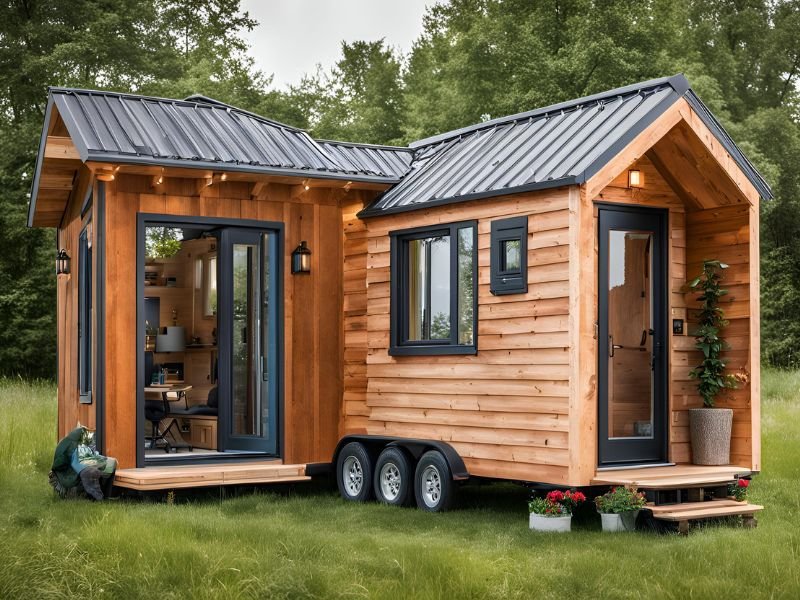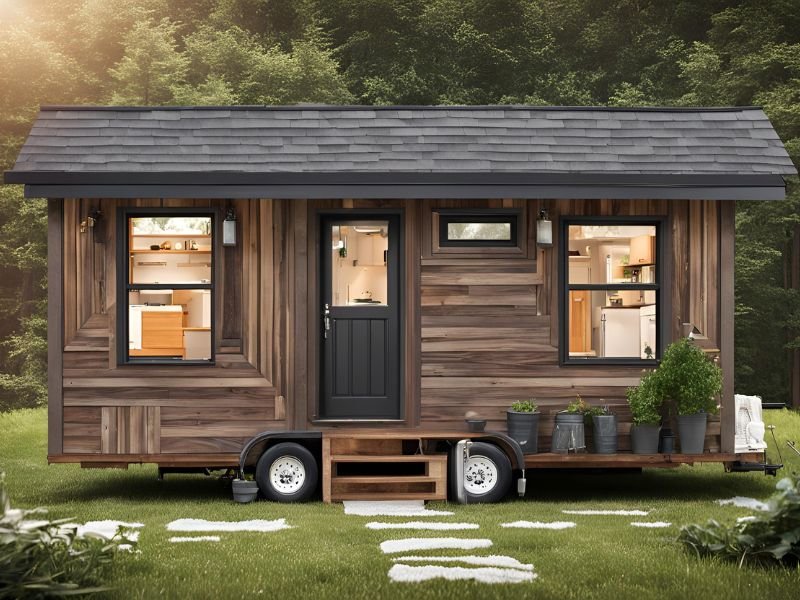Transform your tiny home into an eco-friendly haven by following these practices: composting for waste management, harnessing solar power for energy, rainwater harvesting for conservation, vertical gardening for produce, efficient heating and cooling, minimalistic living, and community resource sharing. These steps reduce your environmental impact and promote sustainability.
Key Takeaways
- Utilize worm composting and Bokashi bins for sustainable waste management.
- Install solar panels for renewable energy in tiny homes.
- Practice rainwater harvesting to conserve water efficiently.
- Grow fresh produce with vertical gardening in small spaces.
- Implement efficient heating/cooling strategies and eco-friendly practices for a greener lifestyle.
Composting for Sustainable Waste Management

When composting in your tiny home, you can effectively manage waste in a sustainable manner. Utilizing methods like worm composting and Bokashi bins can greatly reduce your environmental footprint.
Worm composting, also known as vermicomposting, involves using worms to break down organic materials into nutrient-rich compost. This process is perfect for small spaces and can be done indoors.
On the other hand, Bokashi bins use a fermentation process to decompose food waste rapidly. These bins are a great option for those who want to compost meat, dairy, and other items that may not typically go into a regular compost pile.
Harnessing Solar Power for Energy
To power your tiny home sustainably, consider harnessing solar energy as a clean and renewable source. Solar panel installation is key to maximizing energy efficiency in your small living space. By installing solar panels on your roof or in a sunny spot on your property, you can generate electricity to power your appliances and lighting.
This allows you to embrace off-grid living, reducing your dependence on traditional energy sources and lowering your environmental impact. Embracing renewable energy through solar power not only reduces your carbon footprint but also provides a reliable source of electricity for your tiny home.
Make the most of the sun’s energy and shift towards a more sustainable way of living.
Read More:
- Three Affordable Tips for Tiny Home Community Living
- What Makes Tiny Home Community Living Cost-Effective?
- Top 3 Budget-Friendly Tiny Home Communities
Rainwater Harvesting for Water Conservation
You can optimize your water usage by efficiently collecting rainwater, promoting sustainability in your tiny home.
By harvesting rainwater, you can decrease your environmental impact and preserve local water resources.
Implementing rainwater harvesting practices enables eco-friendly living and helps in conserving water for a greener lifestyle.
Efficient Rainwater Collection
Considering the limited space in a tiny home, efficient rainwater collection systems are essential for sustainable water usage.
Installing water catchment systems on your rooftop is a smart way to make the most of the space available. By directing rainwater into storage tanks, you can have a free and eco-friendly water source for various household tasks.
Additionally, utilizing rain barrels or cisterns can further enhance your ability to collect and store rainwater efficiently. This stored water can then be used for watering rooftop gardens, flushing toilets, or even doing laundry.
Implementing these systems not only reduces your reliance on traditional water sources but also helps in minimizing water wastage within your tiny home.
Sustainable Water Usage
Implementing rainwater harvesting systems in your tiny home is a sustainable practice that can greatly contribute to water conservation efforts. By utilizing rainwater, you can reduce your dependence on traditional water sources and lower your environmental impact. Here are some tips to make the most of rainwater harvesting:
- Install a filtration system to make sure the water collected is free of contaminants.
- Use eco-friendly plumbing fixtures to further enhance water conservation.
- Implement a system to reuse greywater for non-potable purposes.
- Regularly check and maintain your rainwater harvesting system to guarantee peak performance.
Environmental Water Preservation
Rainwater harvesting is a sustainable practice that effectively conserves water resources by collecting and utilizing rainwater for various purposes in tiny home living. By implementing rainwater harvesting systems, you can greatly reduce your dependence on traditional water sources, leading to both cost savings and environmental benefits. In addition, combining rainwater harvesting with water-efficient appliances and greywater recycling systems can further enhance your water conservation efforts.
Here is a table summarizing the benefits of incorporating these eco-friendly practices into your tiny home:
| Environmental Water Preservation Benefits |
|---|
| Reduces water consumption |
| Lowers water bills |
| Decreases strain on local water sources |
| Minimizes environmental impact |
| Promotes sustainable living practices |
Vertical Gardening for Fresh Produce
Looking to maximize your garden space? Vertical gardening offers space-saving solutions for growing fresh produce right at home.
With easy-to-maintain greenery options, you can enjoy a bountiful harvest without taking up much room.
Embracing vertical gardening means you can reap the rewards of homegrown goodness right outside your door.

Space-Saving Garden Solutions
If you’re seeking a practical way to grow fresh produce at home while maximizing space, consider exploring vertical gardening techniques. Vertical gardening can help you cultivate a variety of fruits, vegetables, and herbs without taking up much floor space.
Here are some space-saving garden solutions to get you started:
- Utilize vertical planters or wall-mounted pots to grow plants upwards.
- Incorporate hanging baskets for strawberries, tomatoes, or herbs.
- Create a trellis system for climbing plants like beans, peas, or cucumbers.
- Opt for stackable planters or shelving units to make the most of your vertical space.
Easy-To-Maintain Greenery Options
Consider incorporating low-maintenance greenery options into your vertical garden for easy-to-maintain fresh produce. Utilizing indoor planters or creating a green wall can be excellent ways to grow herbs, vegetables, or fruits in a small space.
Indoor planters, such as hanging planters or wall-mounted pots, are convenient for cultivating herbs like basil, mint, or chives. On the other hand, a green wall can accommodate a variety of plants, providing a vertical space for tomatoes, strawberries, or peppers.
These options not only save space but also add a touch of greenery to your tiny home. By choosing the right plants and maintaining them properly, you can enjoy a bountiful harvest without much effort.
Harvesting From Home
Incorporate vertical gardening techniques for fresh produce by maximizing space and efficiency in your tiny home. Indoor farming and rooftop gardening are excellent ways to grow your own fruits and vegetables while living in a small space.
Here are some tips to help you get started:
- Utilize hanging planters to grow herbs and small vegetables indoors.
- Install vertical garden walls to make the most of your wall space for growing greens.
- Consider setting up a hydroponic system for efficient indoor farming.
- Create a rooftop garden by using containers or raised beds to grow a variety of produce.
Efficient Space Heating and Cooling
Efficiently controlling the temperature in your tiny home is essential for maximizing comfort and energy savings. To achieve this, consider implementing space-saving insulation techniques to trap heat in the winter and keep your home cool in the summer.
Eco-friendly HVAC systems can also help regulate the temperature efficiently while minimizing energy consumption. Opt for programmable thermostats and zone heating/cooling to target specific areas only when needed.
Proper sealing of windows and doors is vital to prevent heat loss or gain. By combining these strategies, you can create a comfortable living environment while reducing your carbon footprint and energy bills.
Minimalistic Living for Reduced Consumption
To reduce consumption and embrace minimalistic living in your tiny home, prioritize functionality and purpose in every item you choose to keep. Start by decluttering, and only hold onto items that serve a specific utility or bring you joy.
Here are some decluttering tips and mindful consumption strategies to help you achieve a minimalist lifestyle:
- Declutter regularly: Set aside time each month to assess your belongings and remove items you no longer need.
- Invest in multifunctional furniture: Choose pieces that serve multiple purposes to maximize space and utility.
- Practice the ‘one in, one out’ rule: For every new item you bring into your home, consider letting go of something else.
- Embrace quality over quantity: Opt for well-made, durable items that will last longer and reduce the need for frequent replacements.
Community Sharing for Resource Optimization
To enhance your eco-friendly practices in tiny home living, consider engaging in community sharing to optimize resources. By participating in community potlucks, you not only reduce individual food waste but also foster a sense of camaraderie and connection within your neighborhood.
Resource swaps allow you to exchange items you no longer need for ones that could be useful to you, promoting a more sustainable way of living. Additionally, shared gardening plots enable you to grow fresh produce collectively, reducing the need for each household to maintain separate gardens.
Utilizing tool libraries within your community helps minimize unnecessary consumption by borrowing items instead of purchasing them individually. Embracing these practices can lead to a more environmentally conscious and socially integrated lifestyle in your tiny home community.
Conclusion
You’ve learned about 7 eco-friendly practices for tiny home living that can help reduce your environmental impact.
Did you know that composting can divert up to 30% of household waste from landfills?
By implementing these practices, you can live a more sustainable lifestyle while also saving money and resources.
So why not start making a difference today in how you live in your tiny home?
Read More:
